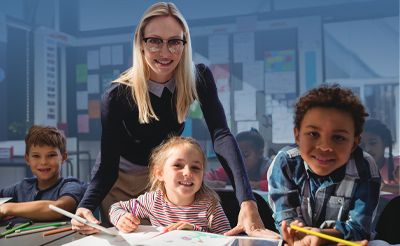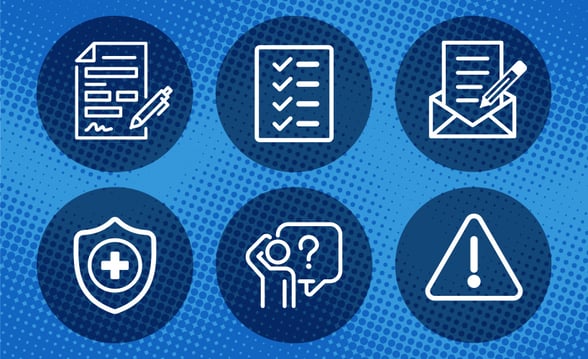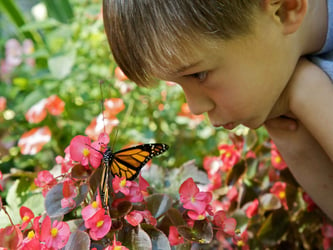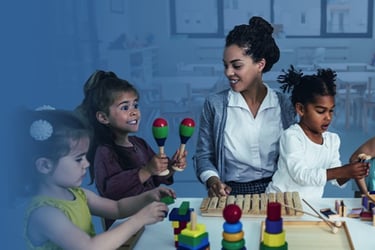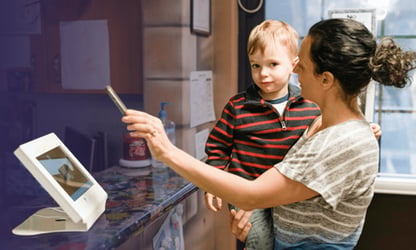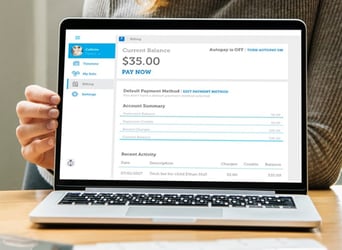
Think about the last time you watched a preschooler discover something new. Maybe they squished mud between their fingers, shook a homemade rattle or giggled as they walked barefoot on grass. That’s sensory development in early childhood in action — real learning happening in real time.
When you introduce fun preschool sensory play ideas for kids, you’re not just entertaining them. You’re helping their brains form crucial connections. You’re refining their coordination through movement-based learning for young children.
Also, you’re making learning stick in a way flashcards never could. So, how can you bring more of these moments into everyday learning? This guide answers that!
Table of Contents
- Benefits of Sensory Activities for Preschoolers
- Best Sensory Activities for Preschoolers
- How to Create a Sensory-Friendly Learning Environment
- DIY and Budget-Friendly Sensory Play Ideas
- FAQs
- Conclusion
- 100+ Editable and Printable Templates to Save Preschools Time!
Benefits of Sensory Activities for Preschoolers
Enhancing Cognitive Development
Preschoolers are natural problem-solvers. They ask endless questions, test out ideas and love figuring things out independently. Sensory activities for preschoolers tap into this curiosity by challenging their brains in fun and meaningful ways.
When a child experiments with how much water a sponge can hold or stacks different-sized blocks in a sensory bin, they learn cause and effect.
These small but essential moments build early reasoning skills.
Improving Fine and Gross Motor Skills
Hand-eye coordination and dexterity don’t develop overnight; they grow with practice, and fine motor skill development through sensory play is one of the most engaging ways to build them, for example:
- Squeezing playdough
- Stringing beads
- Using tongs to pick up pom-poms
All refine the small muscle movements needed for future tasks like holding a pencil or buttoning a coat.
Meanwhile, more significant movements help strengthen coordination and core stability, for example:
- Jumping on bubble wrap
- Crawling through tunnels
- Balancing on a beam
Kids love these activities because they feel like play, but every scoop, stretch and stomp prepares them for more complex physical skills.
Supporting Emotional and Social Growth
Preschoolers experience emotions at full volume; one minute, they’re giggling; the next, they’re on the verge of tears because their sock feels “weird.” Sensory development in early childhood helps them process emotions by giving them an outlet to self-regulate.
A simple activity like running their hands through a bin of soft rice or watching a slow-falling sensory bottle can be incredibly soothing. Sensory play also encourages social interaction.
When kids build together, share materials or solve problems, they practice patience, cooperation and communication. These activities create a sense of security, teaching children how to navigate emotions and relationships naturally and safely.
Encouraging Creativity and Exploration
Preschoolers don’t need instructions to be creative; they need the right materials. Give them scented playdough, colorful water or a tray of different textures, and they’ll dive right in.
Exploring textures in early childhood sparks curiosity as children discover what’s smooth, rough, squishy or sticky. One child might mix colors, while another builds tiny sculptures or enjoys the feeling of cool sand slipping through their fingers.
The best part? There’s no “wrong” way to engage when exploring textures in early childhood. Hands-on learning for preschoolers thrives in an open-ended environment where kids can explore, experiment and create without limits.
Best Sensory Activities for Preschoolers

Touch and Texture-Based Activities
Sensory Bins with Rice, Beans or Sand
There’s something deeply satisfying about running tiny fingers through a bin filled with rice or scooping up a handful of cool, smooth beans. Sensory bins for kids invite preschoolers to dig, pour and sift while secretly strengthening their fine motor skills. You can even hide small toys for a little treasure hunt because what child doesn’t love a surprise?
Playdough and Kinetic Sand Molding
If you’ve ever watched a child squish a fresh ball of playdough, you know the pure joy it brings. There’s something about molding, flattening and rolling that feels like magic.
Kinetic sand takes things up a notch, staying soft yet moldable. Bonus: It’s one of the few messy, oddly satisfying activities to clean up.
Finger Painting and Textured Collages
Yes, finger painting gets messy. However, seeing a child’s eyes light up as they swirl colors together is worth every smudge on the table. Adding textured materials like sandpaper, cotton balls or even crinkled foil to a collage makes for an adventure in touch. It’s creative, sensory-rich and a bit chaotic — in the best way.
Sound and Auditory Sensory Play
DIY Musical Instruments (Shakers, Drums and Rain Sticks)
You don’t need a fancy music set to create a mini percussion band, just empty containers, dried beans and a little imagination. Homemade instruments encourage kids to experiment with sound and rhythm, whether shaking a bottle of rice, banging on an oatmeal container drum or tilting a rain stick to hear the soothing whoosh inside.
It’s an easy way to incorporate fun sensory play ideas for kids while secretly working on their coordination and listening skills. These simple and fun sensory play setups work wonders!
Identifying Sounds Through Listening Games
"Close your eyes and listen. Is that the sound of footsteps? A crinkling wrapper? A dog barking outside?" These are fun sensory play ideas for kids. Sound identification games help preschoolers develop auditory processing skills. It's an affordable sensory play ideas for teachers
You can make it more exciting for your kids by recording household noises and playing games like "Guess that sound,” or take it outdoors and see how many different nature sounds they can find.
Singing and Movement-based Sound Exploration
Preschoolers don’t just listen to music; they feel it with every stomp, clap and twirl. Songs with actions, like “The Hokey Pokey” or “If You’re Happy and You Know It,” help kids engage in movement-based learning for young children while reinforcing rhythm and coordination.
Give them scarves to wave, instruments to shake or let them stomp out the beat with their feet.
Visual Sensory Activities
Color Mixing Experiments with Water or Paint
Watching red and yellow swirl together to make orange is like a magic trick for preschoolers. Color mixing with hands-on experiments introduces early science concepts, whether using water, paint or even colored shaving cream.
You can even encourage kids to predict what will happen before they mix and let them marvel at the results. It’s a creative sensory exploration activity that feels more like play than learning, just how it should be.
Light Table Activities and Shadow Play
A dark room, a flashlight and a little imagination can turn an ordinary afternoon into a storytelling adventure. Light tables or simple shadow play activities encourage preschoolers to experiment with shapes, colors and movement.
They can trace glowing designs, build colorful towers with transparent blocks or create shadow puppets that dance across the wall. It’s one of the best classroom activities for hands-on discovery.
Glow-in-the-dark Sensory Bottles
Typically, there’s something mesmerizing about watching tiny glowing beads drift through the liquid in a sensory bottle.
These simple and fun sensory play setups are perfect for quiet time, giving little ones a calming visual experience.
Fill bottles with glow-in-the-dark paint, glitter or fluorescent beads, then let kids shake them up and watch the magic unfold.
Smell and Taste Sensory Play
Scented Playdough and Spice-smelling Jars
The scent is a powerful trigger for memories, so certain smells instantly transport us to childhood. Let preschoolers explore this connection by kneading scented playdough infused with vanilla, cinnamon or citrus.
Spice-smelling jars, filled with familiar scents like cloves or coffee, encourage kids to describe their smell. It’s a great way to combine sensory play with language development; your classroom or home will smell amazing.
Taste-testing Different Flavors (Sweet, Sour, Salty, Bitter)
Have you ever watched a preschooler try a lemon for the first time? That instant, wide-eyed reaction is priceless.
A simple taste test featuring sweet honey, salty crackers, sour oranges and bitter dark chocolate introduces kids to different flavors while teaching them descriptive words.
It’s a hands-on learning experience that sparks curiosity (and sometimes a few funny faces).
Cooking and Baking Simple, Preschool-friendly Recipes
Mixing, measuring and stirring aren’t just fun; they help kids practice fine motor skills and basic math.
Simple preschool-friendly recipes, like fruit kabobs or no-bake energy balls, offer a delicious way to engage kids in the kitchen.
It’s an affordable sensory play idea for teachers and parents, and the best part is that you get to eat the results together!
Movement and Whole-Body Sensory Activities
Obstacle Courses and Movement Games
Who needs a playground when you have pillows, tunnels and a hallway to run through?
Obstacle courses are a fantastic way to get kids moving while working on balance and coordination. Jump over a pillow, crawl under a chair or hop on one foot — it’s a full-body sensory experience that encourages problem-solving and active play.
Just make sure the coffee table is safely out of the way.
Yoga and Stretching Exercises for Body Awareness
Preschoolers may not master a perfect downward dog, but they will love stretching their arms like a tree or balancing like a flamingo. Yoga is one of the best classroom activities for hands-on discovery.
Yoga and gentle stretches help kids develop spatial awareness and self-regulation, all while improving flexibility. It’s one of the best materials for sensory bins of the body, teaching mindfulness playfully and engagingly.
Bubble Wrap Stomping and Jumping Games
I applaud your self-control if you’ve ever accidentally stepped on bubble wrap and not immediately stomped the rest. For kids, bubble wrap is an irresistible invitation for movement.
Lay it on the floor and let them jump, stomp or tiptoe across to pop as many bubbles as possible. These hands-on learning activities build coordination, balance and just the right amount of chaos. These are crucial in engaging preschoolers with multi-sensory learning.
How to Create a Sensory-Friendly Learning Environment
A sensory-friendly learning environment isn’t just about keeping kids engaged; it’s about helping them feel safe, curious and ready to explore.
Dedicated sensory stations with the best materials for sensory bins, like soft rice, fabulous water beads or squishy playdough, invite endless discovery.
Some kids thrive on movement, so integrating movement-based learning for young children keeps restless energy in check.
Others need the quiet moments, making a cozy, calm-down corner with dim lighting and soft cushions a simple but powerful tool.
Thoughtful adjustments like these don’t just support hands-on learning for preschoolers; they create a classroom where every child feels at home.
DIY and Budget-Friendly Sensory Play Ideas
Using Household Items for Sensory Bins
Sensory play doesn’t need to come with a hefty price tag. You probably have everything right at home or in the recycling bin. The key is to make it engaging, simple and, most importantly, fun for preschoolers.
Dried pasta, rice and beans aren’t just pantry staples; they’re also some of the best materials for sensory bins. They provide different textures and sounds and when paired with scoops or small toys, they become an instant hands-on activity. If a little spills on the floor, consider it a bonus fine motor sensory activity.
Recycled Materials for Hands-on Exploration
Cardboard boxes, fabric scraps and pinecones offer endless opportunities for hands-on learning for preschoolers. For this reason, preschoolers don’t need expensive toys for creative sensory exploration activities.
They can stack, tear, sort or create with these items while boosting their problem-solving skills. It’s incredible how a simple piece of cardboard can turn into a rocket ship, a puzzle or a tiny house.
Free and Low-cost Sensory Games
Water play, scavenger hunts and interactive storytelling are perfect for movement-based learning for young children. Whether searching for colors around the room or splashing in a bin of soapy water, these activities encourage engaging preschoolers with multi-sensory learning while keeping their hands and minds busy.
FAQs
What are the best sensory activities for preschoolers?
The best sensory activities for preschoolers spark curiosity. Let them dig into textured bins, squeeze scented playdough or swirl colors in water.
How often should sensory activities be included in preschool learning?
Daily, if possible! Even short, creative sensory exploration activities help little minds grow.
Can sensory play help children with developmental delays?
Yes! Fine motor skill development through sensory play builds coordination. It also helps in engaging preschoolers with multi-sensory learning.
What materials are best for sensory bins?
Rice, beans, and kinetic sand are the best materials for sensory bins. These are simple yet effective materials for creative sensory exploration activities.
How do sensory activities support language development?
They connect words with experiences. Seeing how sensory activities support brain development is evident when kids describe what they feel and see.
Conclusion
Sensory activities for preschoolers do more than keep little hands busy; they shape how children learn, explore and connect with the world.
Whether squishing playdough, splashing in water or tiptoeing through a texture trail, these experiences fuel fine motor skill development through sensory play and spark curiosity in ways no worksheet ever could.
The exciting part? You don’t need fancy setups. With a bit of creativity, affordable sensory play ideas for teachers and parents can turn everyday moments into powerful learning experiences. Keep it playful, keep it messy and most of all, keep saying “yes” to discover and see how sensory activities support brain development.
100+ Editable and Printable Templates to Save Preschools Time!
We've prepared something special for you - 100+ user-friendly templates to make your important work a little easier. Because the work you do with children matters so very much, and you deserve tools you need.
Get the Full Collection with Just 4 Simple Steps: Assembly Required (0 Minutes)
Step 1: Click button
Step 2: Download 100+ ready-to-use daycare templates
Step 3: Implement immediately
Step 4: Experience efficient childcare management


